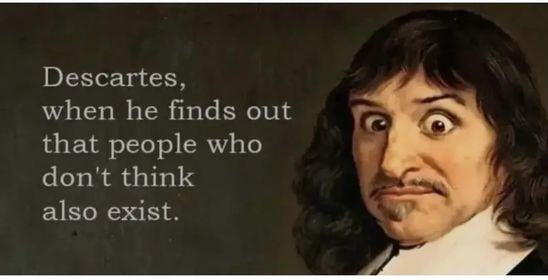In order to truly understand the core of Indian thought, it is important to understand the ontological difference between "Nothing" and "No-thing".
The idea of a "no-thing" is unique to Indian worldview, and to the best of my knowledge, is found nowhere else in philosophies across the world.
The "no-thing" refers to the core of our subjective experience, or pure awareness, or consciousness. To understand this better, we need to start with the notion of inquiry-- where, a subject or the inquirer is inquiring about an object, or the inquired.
All entities that can be objects of inquiry, are "things" and the absence of a thing becomes "nothing". Conventional science today, regards everything as objects, and considers a subject or inquirer, to be just an object when viewed from the vantage point of some other subject.
However, Indian thought argues that what we see about other inquirers are just some objective shell in which the real inquirer resides, and we can never see the real inquirer. We can only see others' body, and to some extent "see" (or infer) their thoughts, emotions, etc. None of these form the core of their subjective experience, or the inquirer.
We can see that, we can become aware of our own bodies, thoughts, emotions, and even our sense of person or ego, in pretty much the same way that we become aware of some object outside of us. The philosopher Ashtavakra, describes succinctly thus:
यथा प्रकाशयाम्येको देहमेनं तथा जगत् ।
अतो मम जगत्सर्वमथवा न च किञ्चन ॥ २ ॥ (Ashtavakra Gita 2.2)As I alone give light to (become aware of) this body, so I do to the world, As a result the whole world is mine, or alternatively, nothing is.
Whatever we consider to be the core of who we are-- like our mind, or intellect, or ego, etc.-- we can become aware of it.. meaning that there is an inquirer separate from all of these. Hence, our body, mind, intellect, emotions, ego, etc. are all objects to our subjective experience! They are all things!
When our mind has several thoughts-- it has a lot of "things" in it, and when our mind is blank, it has "nothing" in it. But the fact that we can discern whether our mind is full of thoughts, or is it blank, means that there exists some other entity that is the core of our subjective experience, that is neither a "thing" nor is it "nothing".
The property of the core of this subjective experience is that it can never be objectified. The core of our subjective experience is a "no-thing". It is not the absence of a thing-- it is an entity that can never be an object of inquiry. The moment we believe that we have located the core of our subjective experience, we can ask, "who" has located this, and realize that the inquirer is the one who is locating.
Philosophers in ancient India-- more than 6000 years ago, had postulated that the core of our subjective experience, which is pure awareness, or consciousness, cannot be objectified in our or anybody else's experience. This means that consciousness exists as a separate entity in the universe, and is not something that is produced by material interactions. This kind of formulation is found in the most ancient philosophical schools of thought in India-- like Samkhya, Nyaya, Vaisheshika, and Yoga.
Modern science still struggles to understand this, and keeps arguing about what does it take for artificial intelligence (AI) to produce consciousness.
About 3500 years ago, there was another great leap in our understanding of consciousness, which is now called Vedanta, and recorded in this vast body of literature, called the Upanishads. The Upanishads brought about one small change to our understanding of "no-things" in that, it argues that there is only one instance of "no-thing" in the entire universe!
This can be illustrated quite easily. All non-physical objects have just one instance. There is just one instance of the number "5" for example. There may be several instances of 5-somethings-- like 5 cows, 5 fingers, etc. But the conceptual object 5 itself, is the same.
This is illustrated by this joke, where a boy is sitting by the roadside and crying. When asked why he is crying, he says that his father gave him five rupees in his left hand, to buy some milk, and another 5 rupees in his right hand, to buy some vegetables. But, the boy says, he forgot and bought milk with the 5 rupees in his right hand, and vegetables with the 5 rupees in his left hand. And now, the boy cries, his father will be very upset with him!
We can see that even though there were multiple instances of the currency, their value referred to just one conceptual object.
The same argument is brought to the core of our subjective inquiry-- by noting that consciousness, even though it exists on its own, is not a physical entity. And because of that, there can be only one instance of it.
Hence, according to the Upanishads, all of us have the very same core, that forms our subjective experience! We are all literally the same being! We may have different bodies, minds, intellects, egos, etc. but the core of all of us is literally the same no-thing!
The Upanishads had such a huge impact on humanity that the author Evan Thompson writes in his book "Waking, Dreaming, Being", that:
“The Upanishads is a watershed in the evolution of consciousness. Instead of being ethnocentric and dividing all global history between B.C. and A.D., we should really divide it between before Upanishads and after Upanishads—B.U. and A.U.—because the sophisticated psychology of consciousness in the Upanishads represents a quantum leap forward in human development.”
But for millennia before the Upanishads, Indian philosophers had postulated the existence of a "no-thing" that is still not realized or acknowledged in modern society. Our no-thing is the core of our subjective experience-- and it is also the source of our sense of agency, freewill, and autonomy.
The introduction of no-thing into our ontological models, would be somewhat akin to the introduction of zero as a number in its own right into a number system. We know that the introduction of zero into a place-holder number system by Bhaskara, was a watershed event in our understanding of numbers and quantities.
If we look at an OWL (Web Ontology Language) ontology today, at the root of this ontology lies an entity called "OWL: Thing". Every other class is a subclass of "OWL:Thing" and is considered a "thing". A pizza is a thing, and so is a person. A table is a thing, and so is a dog.
But we can see that a person or a dog, are more than just things-- unlike a table or a pizza. They have a subjective experience in them, which means that their core is made of the "no-thing". It is because they have a no-thing, they can act on their own, decide on their own, be driven on their own, and their responses to physical stimuli cannot always be predicted by Newtonian models.
All forms of oppression, territorial wars, colonialism, slavery, etc. can be attributed to the fallacy of treating other peoples as things, and oneself as inquirers with agency and desire-- or no-things. Even today, TV anchors urge the world to be more concerned about the war in Ukraine, because "it is not some war in Syria or Africa, but in Europe"-- meaning that, wars in Syria or Africa happen between "things" while a war in Europe involves real people.
It is time we introduce "no-thing" as another root entity in our ontological models.
*~*~*~*~
This blog post is a compilation of my thoughts after watching this video:


